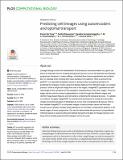| dc.contributor.author | Yang, Karren Dai | |
| dc.contributor.author | Damodaran, Karthik | |
| dc.contributor.author | Venkatachalapathy, Saradha | |
| dc.contributor.author | Soylemezoglu, Ali C. | |
| dc.contributor.author | Shivashankar, G.V. | |
| dc.contributor.author | Uhler, Caroline | |
| dc.date.accessioned | 2021-04-13T19:55:50Z | |
| dc.date.available | 2021-04-13T19:55:50Z | |
| dc.date.issued | 2020-04 | |
| dc.date.submitted | 2019-10 | |
| dc.identifier.issn | 1553-7358 | |
| dc.identifier.uri | https://hdl.handle.net/1721.1/130470 | |
| dc.description.abstract | This is an open access article distributed under the terms of the Creative Commons Attribution License, which permits unrestricted use, distribution, and reproduction in any medium, provided the original author and source are credited. Lineage tracing involves the identification of all ancestors and descendants of a given cell, and is an important tool for studying biological processes such as development and disease progression. However, in many settings, controlled time-course experiments are not feasible, for example when working with tissue samples from patients. Here we present ImageAEOT, a computational pipeline based on autoencoders and optimal transport for predicting the lineages of cells using time-labeled datasets from different stages of a cellular process. Given a single-cell image from one of the stages, ImageAEOT generates an artificial lineage of this cell based on the population characteristics of the other stages. These lineages can be used to connect subpopulations of cells through the different stages and identify image-based features and biomarkers underlying the biological process. To validate our method, we apply ImageAEOT to a benchmark task based on nuclear and chromatin images during the activation of fibroblasts by tumor cells in engineered 3D tissues. We further validate ImageAEOT on chromatin images of various breast cancer cell lines and human tissue samples, thereby linking alterations in chromatin condensation patterns to different stages of tumor progression. Our results demonstrate the promise of computational methods based on autoencoding and optimal transport principles for lineage tracing in settings where existing experimental strategies cannot be used. | en_US |
| dc.description.sponsorship | ONR (Grant N00014-18-1-2765) | en_US |
| dc.language.iso | en | |
| dc.publisher | Public Library of Science (PLoS) | en_US |
| dc.relation.isversionof | http://dx.doi.org/10.1371/journal.pcbi.1007828 | en_US |
| dc.rights | Creative Commons Attribution 4.0 International license | en_US |
| dc.rights.uri | https://creativecommons.org/licenses/by/4.0/ | en_US |
| dc.source | PLoS | en_US |
| dc.title | Predicting cell lineages using autoencoders and optimal transport | en_US |
| dc.type | Article | en_US |
| dc.identifier.citation | Yang, Karren Dai et al. "Predicting cell lineages using autoencoders and optimal transport." PLoS Computational Biology 16, 4 (April 2020): e1007828 © 2020 Yang et al. | en_US |
| dc.contributor.department | Massachusetts Institute of Technology. Institute for Data, Systems, and Society | en_US |
| dc.contributor.department | Massachusetts Institute of Technology. Department of Electrical Engineering and Computer Science | en_US |
| dc.contributor.department | Massachusetts Institute of Technology. Department of Biological Engineering | en_US |
| dc.relation.journal | PLoS Computational Biology | en_US |
| dc.eprint.version | Final published version | en_US |
| dc.type.uri | http://purl.org/eprint/type/JournalArticle | en_US |
| eprint.status | http://purl.org/eprint/status/PeerReviewed | en_US |
| dc.date.updated | 2021-03-19T15:06:50Z | |
| dspace.orderedauthors | Yang, KD; Damodaran, K; Venkatachalapathy, S; Soylemezoglu, AC; Shivashankar, GV; Uhler, C | en_US |
| dspace.date.submission | 2021-03-19T15:06:51Z | |
| mit.journal.volume | 16 | en_US |
| mit.journal.issue | 4 | en_US |
| mit.license | PUBLISHER_CC | |
| mit.metadata.status | Authority Work and Publication Information Needed | |
